Repair Service Management: Process Compliance and ACM Flexibility
VerifiedAdded on 2023/06/12
|10
|3454
|190
Case Study
AI Summary
This case study explores how process compliance and flexibility are addressed within Adaptive Case Management (ACM) systems, focusing on behavioral consistency checking. It reviews an article that examines the integration of process compliance and flexibility using ACM, particularly in scenarios requiring adaptability. The study highlights the challenges in traditional Business Process Management (BPM) systems and proposes ACM as a solution, emphasizing the role of knowledge workers (KWs). The findings indicate that ACM effectively supports business process compliance by empowering users to respond to individually assessed scenarios within defined compliance rules. The research investigates the use of model checking and runtime monitoring techniques to ensure behavioral consistency, supporting both predefined process templates and ad hoc actions. A practical ACM system for repair service management is used as a case study, demonstrating the application of consistency checking and compliance laws. The study also identifies the importance of addressing both predictable and unpredictable business situations, with business administrators preparing for new scenarios and KWs creating ad hoc actions from generic templates. The research concludes by emphasizing the need for better Repair Service Management (RSM) tools to enhance business process compliance, flexibility, and rapid adaptation to changing laws.

Process compliance and Flexibility 1
Article Review: How to Embrace Business Process Compliance And Flexibility Via
Behavioral Consistency Checking In ACM
Name
Tutor
University
Course
City/State
Date
Article Review: How to Embrace Business Process Compliance And Flexibility Via
Behavioral Consistency Checking In ACM
Name
Tutor
University
Course
City/State
Date
Paraphrase This Document
Need a fresh take? Get an instant paraphrase of this document with our AI Paraphraser
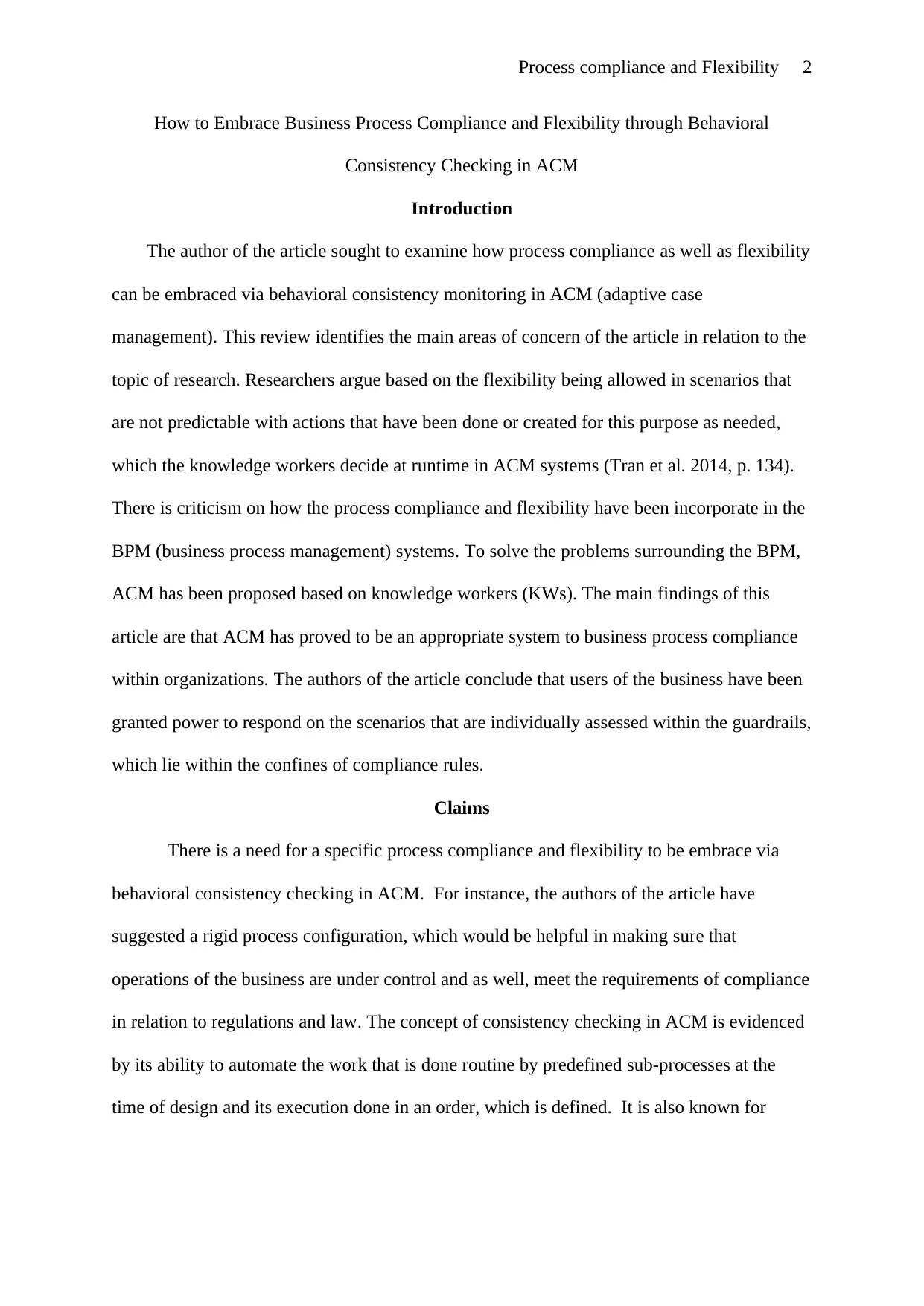
Process compliance and Flexibility 2
How to Embrace Business Process Compliance and Flexibility through Behavioral
Consistency Checking in ACM
Introduction
The author of the article sought to examine how process compliance as well as flexibility
can be embraced via behavioral consistency monitoring in ACM (adaptive case
management). This review identifies the main areas of concern of the article in relation to the
topic of research. Researchers argue based on the flexibility being allowed in scenarios that
are not predictable with actions that have been done or created for this purpose as needed,
which the knowledge workers decide at runtime in ACM systems (Tran et al. 2014, p. 134).
There is criticism on how the process compliance and flexibility have been incorporate in the
BPM (business process management) systems. To solve the problems surrounding the BPM,
ACM has been proposed based on knowledge workers (KWs). The main findings of this
article are that ACM has proved to be an appropriate system to business process compliance
within organizations. The authors of the article conclude that users of the business have been
granted power to respond on the scenarios that are individually assessed within the guardrails,
which lie within the confines of compliance rules.
Claims
There is a need for a specific process compliance and flexibility to be embrace via
behavioral consistency checking in ACM. For instance, the authors of the article have
suggested a rigid process configuration, which would be helpful in making sure that
operations of the business are under control and as well, meet the requirements of compliance
in relation to regulations and law. The concept of consistency checking in ACM is evidenced
by its ability to automate the work that is done routine by predefined sub-processes at the
time of design and its execution done in an order, which is defined. It is also known for
How to Embrace Business Process Compliance and Flexibility through Behavioral
Consistency Checking in ACM
Introduction
The author of the article sought to examine how process compliance as well as flexibility
can be embraced via behavioral consistency monitoring in ACM (adaptive case
management). This review identifies the main areas of concern of the article in relation to the
topic of research. Researchers argue based on the flexibility being allowed in scenarios that
are not predictable with actions that have been done or created for this purpose as needed,
which the knowledge workers decide at runtime in ACM systems (Tran et al. 2014, p. 134).
There is criticism on how the process compliance and flexibility have been incorporate in the
BPM (business process management) systems. To solve the problems surrounding the BPM,
ACM has been proposed based on knowledge workers (KWs). The main findings of this
article are that ACM has proved to be an appropriate system to business process compliance
within organizations. The authors of the article conclude that users of the business have been
granted power to respond on the scenarios that are individually assessed within the guardrails,
which lie within the confines of compliance rules.
Claims
There is a need for a specific process compliance and flexibility to be embrace via
behavioral consistency checking in ACM. For instance, the authors of the article have
suggested a rigid process configuration, which would be helpful in making sure that
operations of the business are under control and as well, meet the requirements of compliance
in relation to regulations and law. The concept of consistency checking in ACM is evidenced
by its ability to automate the work that is done routine by predefined sub-processes at the
time of design and its execution done in an order, which is defined. It is also known for

Process compliance and Flexibility 3
being flexible by the activities’ free design as well as their order via ad hoc tasks and goals,
whose addition is made at runtime by the Knowledge workers (Thi Kim et al. 2016, p. 45).
There is also a claim that most of the firms are focusing on making sure that business
processes are compliant with the regulations. Many researchers have been encouraged by this
concern to conduct studies on such relationship. The reason for this claim is that there is a
need for the business process compliance, which would be helpful in offering the complete
coverage of the lifecycle of the business process, ranging from the plan of the compliance-
aware process to the evaluation of post-execution (Cabanillas, Resinas, & Ruiz-Cort´es,
2011, p. 219). The coverage also takes into account the process of auditing.
Another claim is that there is a need for monitoring the runtime with a view to
watching and checking the behavior of the system keenly for a given period for the discovery
of the likely problems as argued by Babaee and Babamir (2013, p. 215). The monitors used
for this purpose aims at retaining two empowering attributes which include determination
and audition in relation to KWs. The article has placed its focus on compliance checking at
runtime, where there is creation of ad hoc actions by KWs to attain the main goal of the
system suggested in this study. Thi Kim et al. (2016, p. 43) further supports this reason by
positing that actions that are ad hoc as well as the shifts in the course of runtime has been
allowed in the principle of ACM which enables the users to act as KWs for the evolutions of
the processes of the business. Such processes have been expected to embrace both the
support of business scenarios that are predictable by use of well-defined sub-processes and
the business situations, which are not predictable (Maggi et al. 2011, p. 131; Thi Kim et al.
2016, p. 43).
Reasons for Conducting the Research
being flexible by the activities’ free design as well as their order via ad hoc tasks and goals,
whose addition is made at runtime by the Knowledge workers (Thi Kim et al. 2016, p. 45).
There is also a claim that most of the firms are focusing on making sure that business
processes are compliant with the regulations. Many researchers have been encouraged by this
concern to conduct studies on such relationship. The reason for this claim is that there is a
need for the business process compliance, which would be helpful in offering the complete
coverage of the lifecycle of the business process, ranging from the plan of the compliance-
aware process to the evaluation of post-execution (Cabanillas, Resinas, & Ruiz-Cort´es,
2011, p. 219). The coverage also takes into account the process of auditing.
Another claim is that there is a need for monitoring the runtime with a view to
watching and checking the behavior of the system keenly for a given period for the discovery
of the likely problems as argued by Babaee and Babamir (2013, p. 215). The monitors used
for this purpose aims at retaining two empowering attributes which include determination
and audition in relation to KWs. The article has placed its focus on compliance checking at
runtime, where there is creation of ad hoc actions by KWs to attain the main goal of the
system suggested in this study. Thi Kim et al. (2016, p. 43) further supports this reason by
positing that actions that are ad hoc as well as the shifts in the course of runtime has been
allowed in the principle of ACM which enables the users to act as KWs for the evolutions of
the processes of the business. Such processes have been expected to embrace both the
support of business scenarios that are predictable by use of well-defined sub-processes and
the business situations, which are not predictable (Maggi et al. 2011, p. 131; Thi Kim et al.
2016, p. 43).
Reasons for Conducting the Research
⊘ This is a preview!⊘
Do you want full access?
Subscribe today to unlock all pages.

Trusted by 1+ million students worldwide
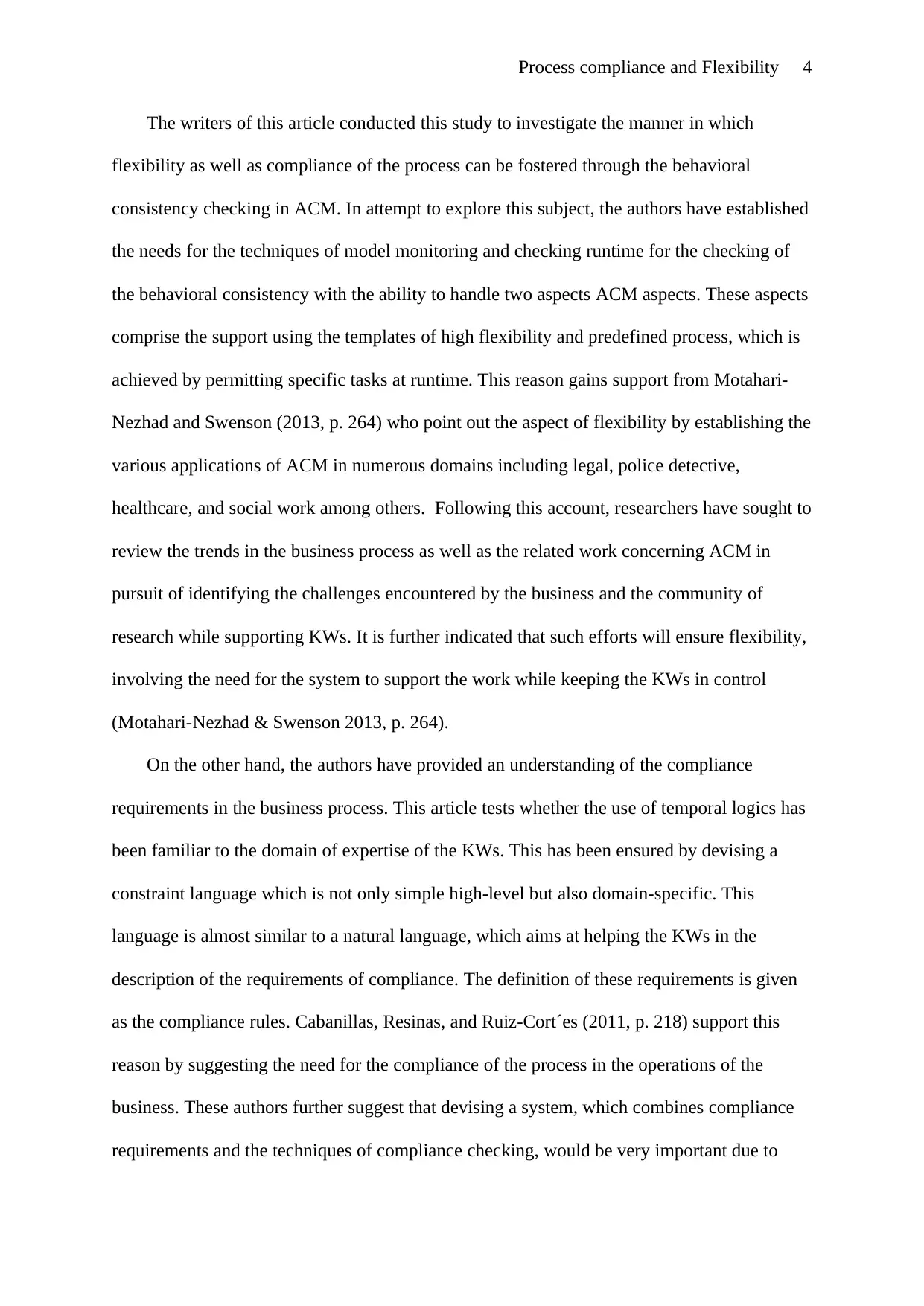
Process compliance and Flexibility 4
The writers of this article conducted this study to investigate the manner in which
flexibility as well as compliance of the process can be fostered through the behavioral
consistency checking in ACM. In attempt to explore this subject, the authors have established
the needs for the techniques of model monitoring and checking runtime for the checking of
the behavioral consistency with the ability to handle two aspects ACM aspects. These aspects
comprise the support using the templates of high flexibility and predefined process, which is
achieved by permitting specific tasks at runtime. This reason gains support from Motahari-
Nezhad and Swenson (2013, p. 264) who point out the aspect of flexibility by establishing the
various applications of ACM in numerous domains including legal, police detective,
healthcare, and social work among others. Following this account, researchers have sought to
review the trends in the business process as well as the related work concerning ACM in
pursuit of identifying the challenges encountered by the business and the community of
research while supporting KWs. It is further indicated that such efforts will ensure flexibility,
involving the need for the system to support the work while keeping the KWs in control
(Motahari-Nezhad & Swenson 2013, p. 264).
On the other hand, the authors have provided an understanding of the compliance
requirements in the business process. This article tests whether the use of temporal logics has
been familiar to the domain of expertise of the KWs. This has been ensured by devising a
constraint language which is not only simple high-level but also domain-specific. This
language is almost similar to a natural language, which aims at helping the KWs in the
description of the requirements of compliance. The definition of these requirements is given
as the compliance rules. Cabanillas, Resinas, and Ruiz-Cort´es (2011, p. 218) support this
reason by suggesting the need for the compliance of the process in the operations of the
business. These authors further suggest that devising a system, which combines compliance
requirements and the techniques of compliance checking, would be very important due to
The writers of this article conducted this study to investigate the manner in which
flexibility as well as compliance of the process can be fostered through the behavioral
consistency checking in ACM. In attempt to explore this subject, the authors have established
the needs for the techniques of model monitoring and checking runtime for the checking of
the behavioral consistency with the ability to handle two aspects ACM aspects. These aspects
comprise the support using the templates of high flexibility and predefined process, which is
achieved by permitting specific tasks at runtime. This reason gains support from Motahari-
Nezhad and Swenson (2013, p. 264) who point out the aspect of flexibility by establishing the
various applications of ACM in numerous domains including legal, police detective,
healthcare, and social work among others. Following this account, researchers have sought to
review the trends in the business process as well as the related work concerning ACM in
pursuit of identifying the challenges encountered by the business and the community of
research while supporting KWs. It is further indicated that such efforts will ensure flexibility,
involving the need for the system to support the work while keeping the KWs in control
(Motahari-Nezhad & Swenson 2013, p. 264).
On the other hand, the authors have provided an understanding of the compliance
requirements in the business process. This article tests whether the use of temporal logics has
been familiar to the domain of expertise of the KWs. This has been ensured by devising a
constraint language which is not only simple high-level but also domain-specific. This
language is almost similar to a natural language, which aims at helping the KWs in the
description of the requirements of compliance. The definition of these requirements is given
as the compliance rules. Cabanillas, Resinas, and Ruiz-Cort´es (2011, p. 218) support this
reason by suggesting the need for the compliance of the process in the operations of the
business. These authors further suggest that devising a system, which combines compliance
requirements and the techniques of compliance checking, would be very important due to
Paraphrase This Document
Need a fresh take? Get an instant paraphrase of this document with our AI Paraphraser
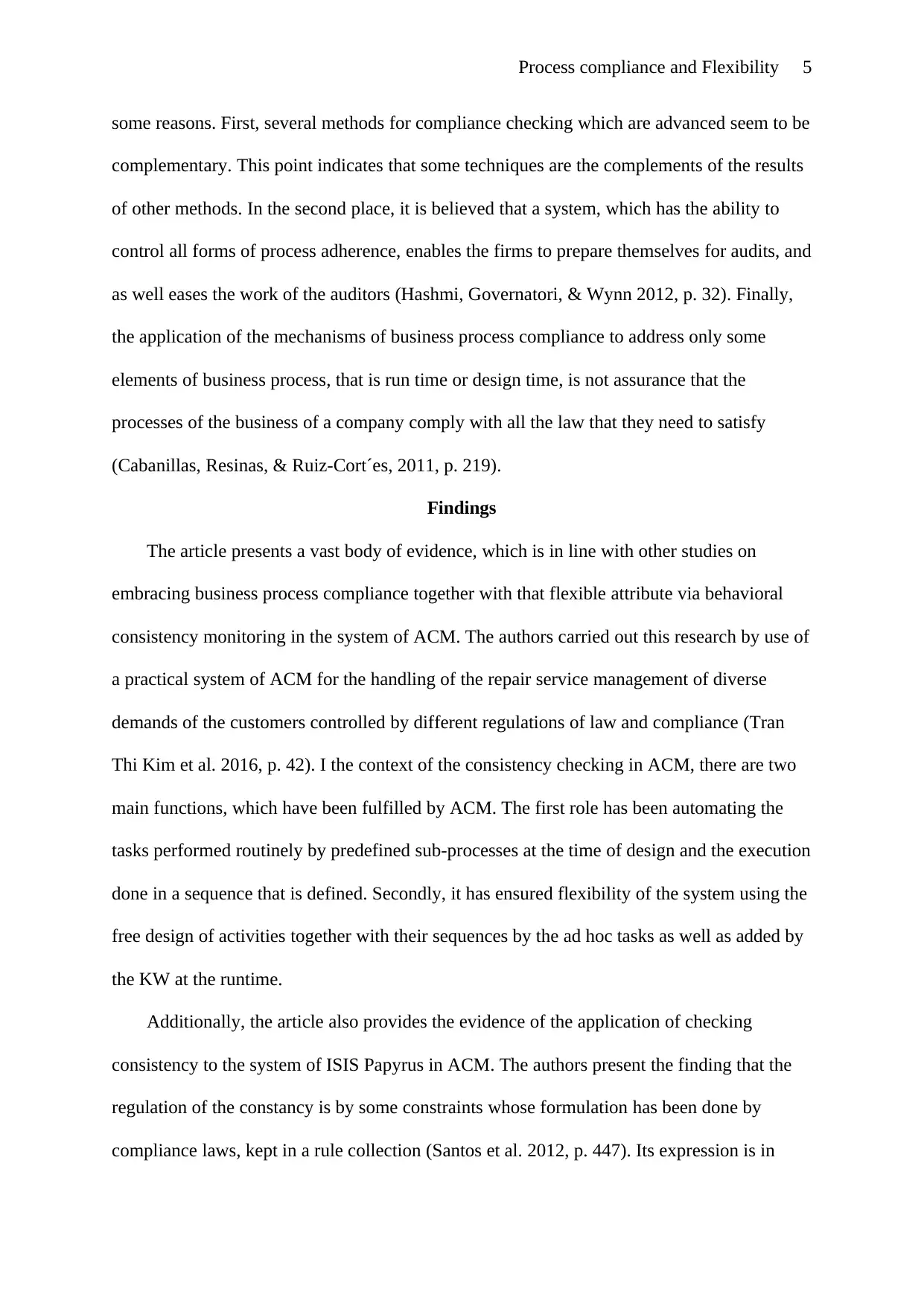
Process compliance and Flexibility 5
some reasons. First, several methods for compliance checking which are advanced seem to be
complementary. This point indicates that some techniques are the complements of the results
of other methods. In the second place, it is believed that a system, which has the ability to
control all forms of process adherence, enables the firms to prepare themselves for audits, and
as well eases the work of the auditors (Hashmi, Governatori, & Wynn 2012, p. 32). Finally,
the application of the mechanisms of business process compliance to address only some
elements of business process, that is run time or design time, is not assurance that the
processes of the business of a company comply with all the law that they need to satisfy
(Cabanillas, Resinas, & Ruiz-Cort´es, 2011, p. 219).
Findings
The article presents a vast body of evidence, which is in line with other studies on
embracing business process compliance together with that flexible attribute via behavioral
consistency monitoring in the system of ACM. The authors carried out this research by use of
a practical system of ACM for the handling of the repair service management of diverse
demands of the customers controlled by different regulations of law and compliance (Tran
Thi Kim et al. 2016, p. 42). I the context of the consistency checking in ACM, there are two
main functions, which have been fulfilled by ACM. The first role has been automating the
tasks performed routinely by predefined sub-processes at the time of design and the execution
done in a sequence that is defined. Secondly, it has ensured flexibility of the system using the
free design of activities together with their sequences by the ad hoc tasks as well as added by
the KW at the runtime.
Additionally, the article also provides the evidence of the application of checking
consistency to the system of ISIS Papyrus in ACM. The authors present the finding that the
regulation of the constancy is by some constraints whose formulation has been done by
compliance laws, kept in a rule collection (Santos et al. 2012, p. 447). Its expression is in
some reasons. First, several methods for compliance checking which are advanced seem to be
complementary. This point indicates that some techniques are the complements of the results
of other methods. In the second place, it is believed that a system, which has the ability to
control all forms of process adherence, enables the firms to prepare themselves for audits, and
as well eases the work of the auditors (Hashmi, Governatori, & Wynn 2012, p. 32). Finally,
the application of the mechanisms of business process compliance to address only some
elements of business process, that is run time or design time, is not assurance that the
processes of the business of a company comply with all the law that they need to satisfy
(Cabanillas, Resinas, & Ruiz-Cort´es, 2011, p. 219).
Findings
The article presents a vast body of evidence, which is in line with other studies on
embracing business process compliance together with that flexible attribute via behavioral
consistency monitoring in the system of ACM. The authors carried out this research by use of
a practical system of ACM for the handling of the repair service management of diverse
demands of the customers controlled by different regulations of law and compliance (Tran
Thi Kim et al. 2016, p. 42). I the context of the consistency checking in ACM, there are two
main functions, which have been fulfilled by ACM. The first role has been automating the
tasks performed routinely by predefined sub-processes at the time of design and the execution
done in a sequence that is defined. Secondly, it has ensured flexibility of the system using the
free design of activities together with their sequences by the ad hoc tasks as well as added by
the KW at the runtime.
Additionally, the article also provides the evidence of the application of checking
consistency to the system of ISIS Papyrus in ACM. The authors present the finding that the
regulation of the constancy is by some constraints whose formulation has been done by
compliance laws, kept in a rule collection (Santos et al. 2012, p. 447). Its expression is in
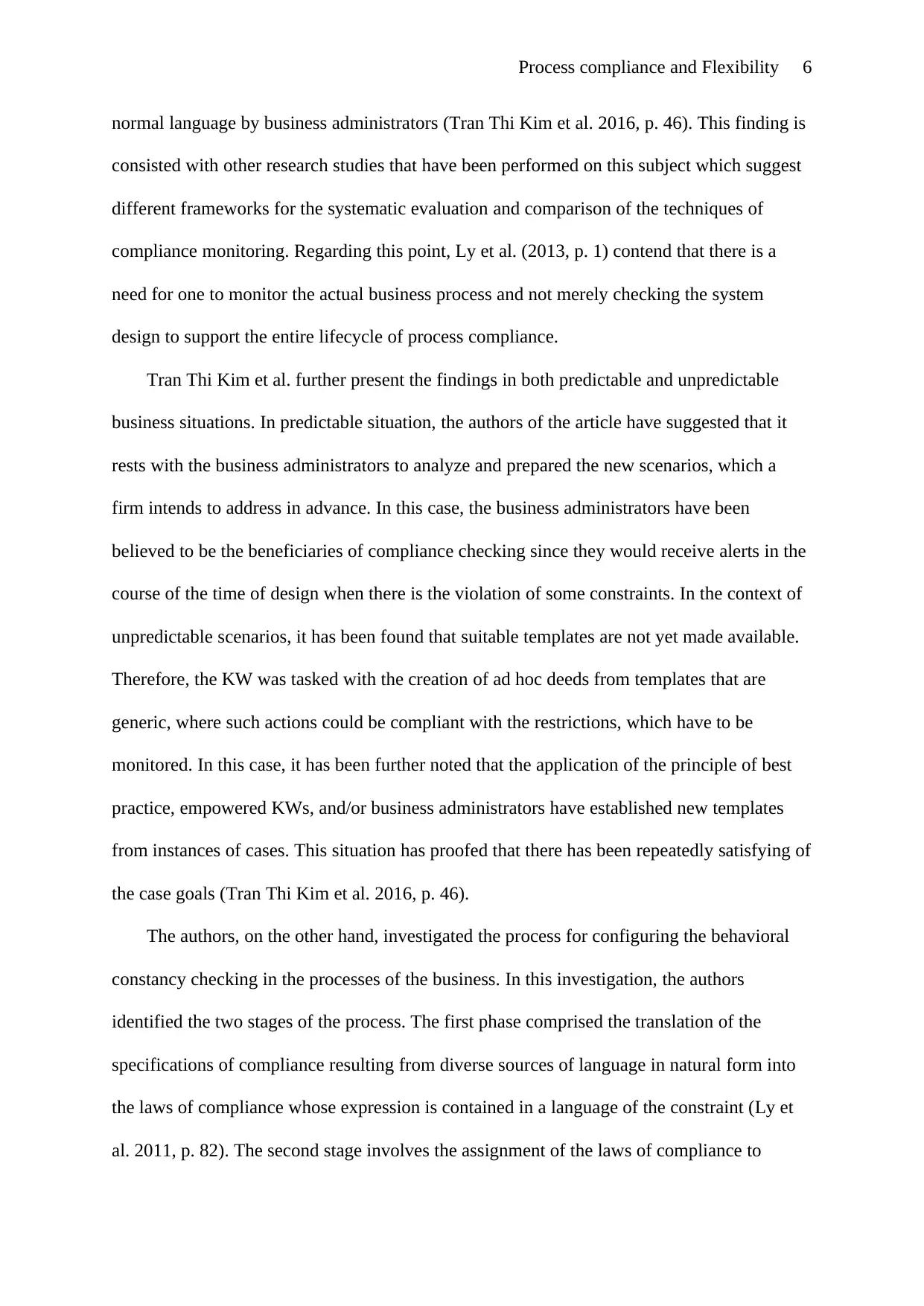
Process compliance and Flexibility 6
normal language by business administrators (Tran Thi Kim et al. 2016, p. 46). This finding is
consisted with other research studies that have been performed on this subject which suggest
different frameworks for the systematic evaluation and comparison of the techniques of
compliance monitoring. Regarding this point, Ly et al. (2013, p. 1) contend that there is a
need for one to monitor the actual business process and not merely checking the system
design to support the entire lifecycle of process compliance.
Tran Thi Kim et al. further present the findings in both predictable and unpredictable
business situations. In predictable situation, the authors of the article have suggested that it
rests with the business administrators to analyze and prepared the new scenarios, which a
firm intends to address in advance. In this case, the business administrators have been
believed to be the beneficiaries of compliance checking since they would receive alerts in the
course of the time of design when there is the violation of some constraints. In the context of
unpredictable scenarios, it has been found that suitable templates are not yet made available.
Therefore, the KW was tasked with the creation of ad hoc deeds from templates that are
generic, where such actions could be compliant with the restrictions, which have to be
monitored. In this case, it has been further noted that the application of the principle of best
practice, empowered KWs, and/or business administrators have established new templates
from instances of cases. This situation has proofed that there has been repeatedly satisfying of
the case goals (Tran Thi Kim et al. 2016, p. 46).
The authors, on the other hand, investigated the process for configuring the behavioral
constancy checking in the processes of the business. In this investigation, the authors
identified the two stages of the process. The first phase comprised the translation of the
specifications of compliance resulting from diverse sources of language in natural form into
the laws of compliance whose expression is contained in a language of the constraint (Ly et
al. 2011, p. 82). The second stage involves the assignment of the laws of compliance to
normal language by business administrators (Tran Thi Kim et al. 2016, p. 46). This finding is
consisted with other research studies that have been performed on this subject which suggest
different frameworks for the systematic evaluation and comparison of the techniques of
compliance monitoring. Regarding this point, Ly et al. (2013, p. 1) contend that there is a
need for one to monitor the actual business process and not merely checking the system
design to support the entire lifecycle of process compliance.
Tran Thi Kim et al. further present the findings in both predictable and unpredictable
business situations. In predictable situation, the authors of the article have suggested that it
rests with the business administrators to analyze and prepared the new scenarios, which a
firm intends to address in advance. In this case, the business administrators have been
believed to be the beneficiaries of compliance checking since they would receive alerts in the
course of the time of design when there is the violation of some constraints. In the context of
unpredictable scenarios, it has been found that suitable templates are not yet made available.
Therefore, the KW was tasked with the creation of ad hoc deeds from templates that are
generic, where such actions could be compliant with the restrictions, which have to be
monitored. In this case, it has been further noted that the application of the principle of best
practice, empowered KWs, and/or business administrators have established new templates
from instances of cases. This situation has proofed that there has been repeatedly satisfying of
the case goals (Tran Thi Kim et al. 2016, p. 46).
The authors, on the other hand, investigated the process for configuring the behavioral
constancy checking in the processes of the business. In this investigation, the authors
identified the two stages of the process. The first phase comprised the translation of the
specifications of compliance resulting from diverse sources of language in natural form into
the laws of compliance whose expression is contained in a language of the constraint (Ly et
al. 2011, p. 82). The second stage involves the assignment of the laws of compliance to
⊘ This is a preview!⊘
Do you want full access?
Subscribe today to unlock all pages.

Trusted by 1+ million students worldwide
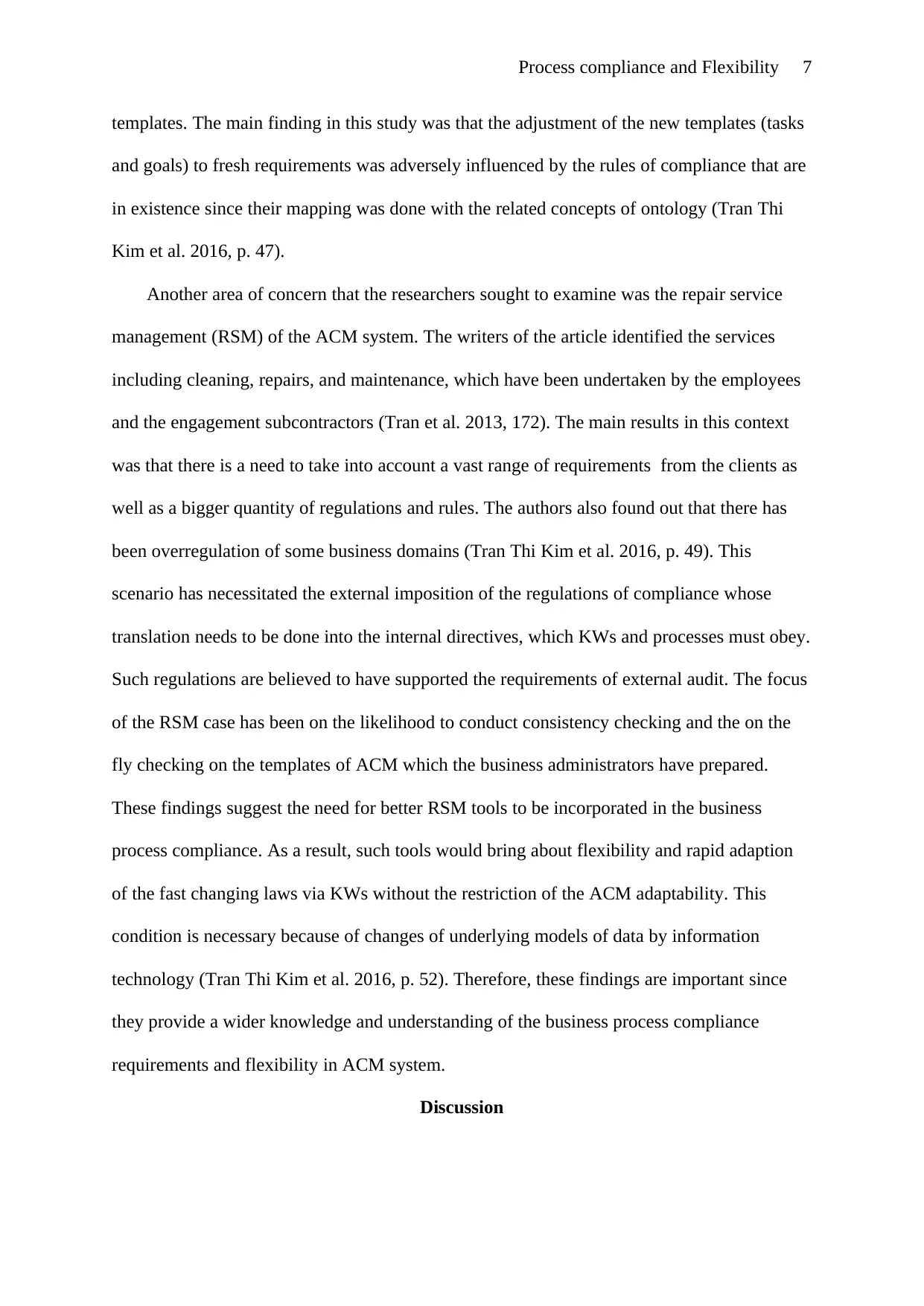
Process compliance and Flexibility 7
templates. The main finding in this study was that the adjustment of the new templates (tasks
and goals) to fresh requirements was adversely influenced by the rules of compliance that are
in existence since their mapping was done with the related concepts of ontology (Tran Thi
Kim et al. 2016, p. 47).
Another area of concern that the researchers sought to examine was the repair service
management (RSM) of the ACM system. The writers of the article identified the services
including cleaning, repairs, and maintenance, which have been undertaken by the employees
and the engagement subcontractors (Tran et al. 2013, 172). The main results in this context
was that there is a need to take into account a vast range of requirements from the clients as
well as a bigger quantity of regulations and rules. The authors also found out that there has
been overregulation of some business domains (Tran Thi Kim et al. 2016, p. 49). This
scenario has necessitated the external imposition of the regulations of compliance whose
translation needs to be done into the internal directives, which KWs and processes must obey.
Such regulations are believed to have supported the requirements of external audit. The focus
of the RSM case has been on the likelihood to conduct consistency checking and the on the
fly checking on the templates of ACM which the business administrators have prepared.
These findings suggest the need for better RSM tools to be incorporated in the business
process compliance. As a result, such tools would bring about flexibility and rapid adaption
of the fast changing laws via KWs without the restriction of the ACM adaptability. This
condition is necessary because of changes of underlying models of data by information
technology (Tran Thi Kim et al. 2016, p. 52). Therefore, these findings are important since
they provide a wider knowledge and understanding of the business process compliance
requirements and flexibility in ACM system.
Discussion
templates. The main finding in this study was that the adjustment of the new templates (tasks
and goals) to fresh requirements was adversely influenced by the rules of compliance that are
in existence since their mapping was done with the related concepts of ontology (Tran Thi
Kim et al. 2016, p. 47).
Another area of concern that the researchers sought to examine was the repair service
management (RSM) of the ACM system. The writers of the article identified the services
including cleaning, repairs, and maintenance, which have been undertaken by the employees
and the engagement subcontractors (Tran et al. 2013, 172). The main results in this context
was that there is a need to take into account a vast range of requirements from the clients as
well as a bigger quantity of regulations and rules. The authors also found out that there has
been overregulation of some business domains (Tran Thi Kim et al. 2016, p. 49). This
scenario has necessitated the external imposition of the regulations of compliance whose
translation needs to be done into the internal directives, which KWs and processes must obey.
Such regulations are believed to have supported the requirements of external audit. The focus
of the RSM case has been on the likelihood to conduct consistency checking and the on the
fly checking on the templates of ACM which the business administrators have prepared.
These findings suggest the need for better RSM tools to be incorporated in the business
process compliance. As a result, such tools would bring about flexibility and rapid adaption
of the fast changing laws via KWs without the restriction of the ACM adaptability. This
condition is necessary because of changes of underlying models of data by information
technology (Tran Thi Kim et al. 2016, p. 52). Therefore, these findings are important since
they provide a wider knowledge and understanding of the business process compliance
requirements and flexibility in ACM system.
Discussion
Paraphrase This Document
Need a fresh take? Get an instant paraphrase of this document with our AI Paraphraser
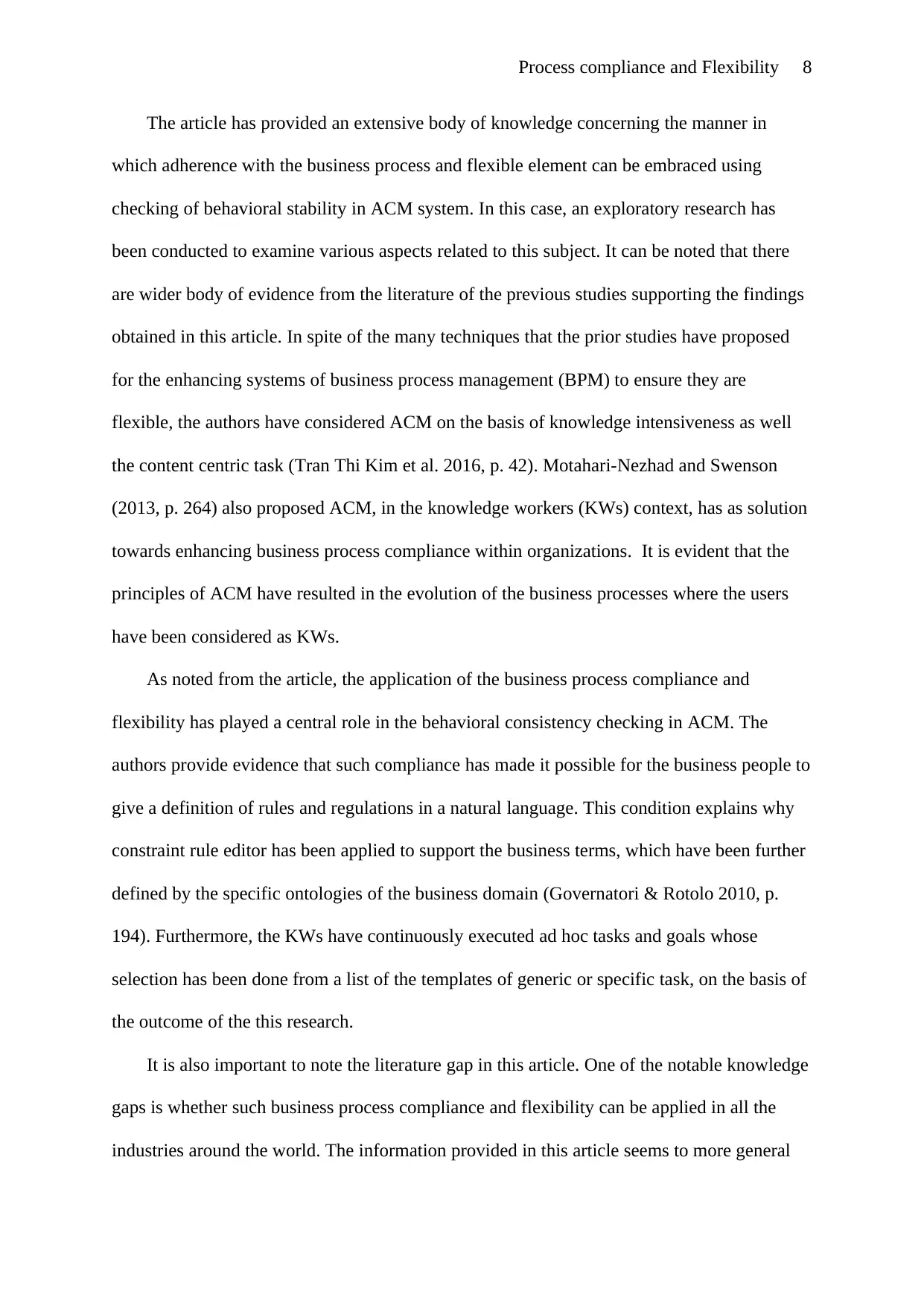
Process compliance and Flexibility 8
The article has provided an extensive body of knowledge concerning the manner in
which adherence with the business process and flexible element can be embraced using
checking of behavioral stability in ACM system. In this case, an exploratory research has
been conducted to examine various aspects related to this subject. It can be noted that there
are wider body of evidence from the literature of the previous studies supporting the findings
obtained in this article. In spite of the many techniques that the prior studies have proposed
for the enhancing systems of business process management (BPM) to ensure they are
flexible, the authors have considered ACM on the basis of knowledge intensiveness as well
the content centric task (Tran Thi Kim et al. 2016, p. 42). Motahari-Nezhad and Swenson
(2013, p. 264) also proposed ACM, in the knowledge workers (KWs) context, has as solution
towards enhancing business process compliance within organizations. It is evident that the
principles of ACM have resulted in the evolution of the business processes where the users
have been considered as KWs.
As noted from the article, the application of the business process compliance and
flexibility has played a central role in the behavioral consistency checking in ACM. The
authors provide evidence that such compliance has made it possible for the business people to
give a definition of rules and regulations in a natural language. This condition explains why
constraint rule editor has been applied to support the business terms, which have been further
defined by the specific ontologies of the business domain (Governatori & Rotolo 2010, p.
194). Furthermore, the KWs have continuously executed ad hoc tasks and goals whose
selection has been done from a list of the templates of generic or specific task, on the basis of
the outcome of the this research.
It is also important to note the literature gap in this article. One of the notable knowledge
gaps is whether such business process compliance and flexibility can be applied in all the
industries around the world. The information provided in this article seems to more general
The article has provided an extensive body of knowledge concerning the manner in
which adherence with the business process and flexible element can be embraced using
checking of behavioral stability in ACM system. In this case, an exploratory research has
been conducted to examine various aspects related to this subject. It can be noted that there
are wider body of evidence from the literature of the previous studies supporting the findings
obtained in this article. In spite of the many techniques that the prior studies have proposed
for the enhancing systems of business process management (BPM) to ensure they are
flexible, the authors have considered ACM on the basis of knowledge intensiveness as well
the content centric task (Tran Thi Kim et al. 2016, p. 42). Motahari-Nezhad and Swenson
(2013, p. 264) also proposed ACM, in the knowledge workers (KWs) context, has as solution
towards enhancing business process compliance within organizations. It is evident that the
principles of ACM have resulted in the evolution of the business processes where the users
have been considered as KWs.
As noted from the article, the application of the business process compliance and
flexibility has played a central role in the behavioral consistency checking in ACM. The
authors provide evidence that such compliance has made it possible for the business people to
give a definition of rules and regulations in a natural language. This condition explains why
constraint rule editor has been applied to support the business terms, which have been further
defined by the specific ontologies of the business domain (Governatori & Rotolo 2010, p.
194). Furthermore, the KWs have continuously executed ad hoc tasks and goals whose
selection has been done from a list of the templates of generic or specific task, on the basis of
the outcome of the this research.
It is also important to note the literature gap in this article. One of the notable knowledge
gaps is whether such business process compliance and flexibility can be applied in all the
industries around the world. The information provided in this article seems to more general
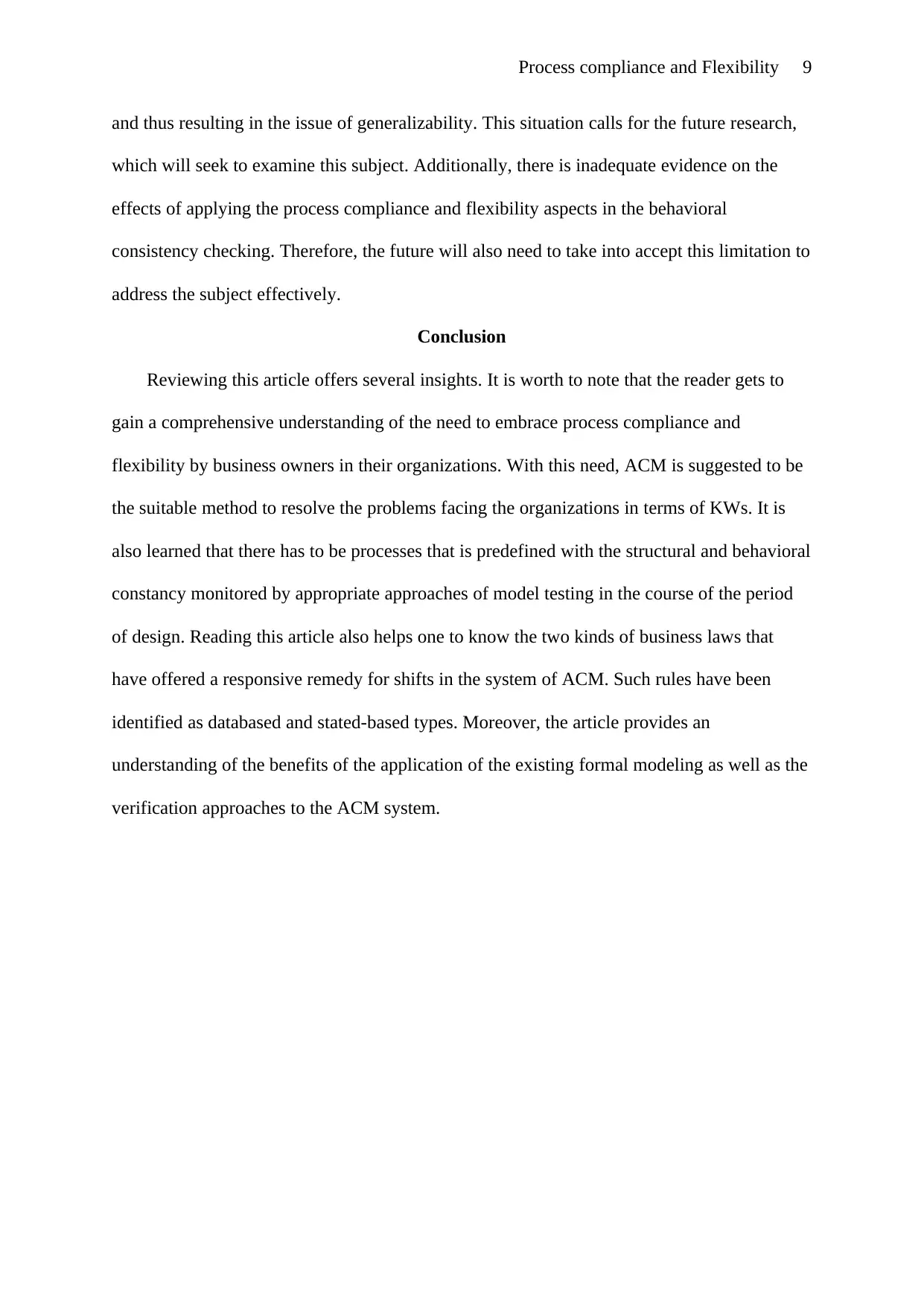
Process compliance and Flexibility 9
and thus resulting in the issue of generalizability. This situation calls for the future research,
which will seek to examine this subject. Additionally, there is inadequate evidence on the
effects of applying the process compliance and flexibility aspects in the behavioral
consistency checking. Therefore, the future will also need to take into accept this limitation to
address the subject effectively.
Conclusion
Reviewing this article offers several insights. It is worth to note that the reader gets to
gain a comprehensive understanding of the need to embrace process compliance and
flexibility by business owners in their organizations. With this need, ACM is suggested to be
the suitable method to resolve the problems facing the organizations in terms of KWs. It is
also learned that there has to be processes that is predefined with the structural and behavioral
constancy monitored by appropriate approaches of model testing in the course of the period
of design. Reading this article also helps one to know the two kinds of business laws that
have offered a responsive remedy for shifts in the system of ACM. Such rules have been
identified as databased and stated-based types. Moreover, the article provides an
understanding of the benefits of the application of the existing formal modeling as well as the
verification approaches to the ACM system.
and thus resulting in the issue of generalizability. This situation calls for the future research,
which will seek to examine this subject. Additionally, there is inadequate evidence on the
effects of applying the process compliance and flexibility aspects in the behavioral
consistency checking. Therefore, the future will also need to take into accept this limitation to
address the subject effectively.
Conclusion
Reviewing this article offers several insights. It is worth to note that the reader gets to
gain a comprehensive understanding of the need to embrace process compliance and
flexibility by business owners in their organizations. With this need, ACM is suggested to be
the suitable method to resolve the problems facing the organizations in terms of KWs. It is
also learned that there has to be processes that is predefined with the structural and behavioral
constancy monitored by appropriate approaches of model testing in the course of the period
of design. Reading this article also helps one to know the two kinds of business laws that
have offered a responsive remedy for shifts in the system of ACM. Such rules have been
identified as databased and stated-based types. Moreover, the article provides an
understanding of the benefits of the application of the existing formal modeling as well as the
verification approaches to the ACM system.
⊘ This is a preview!⊘
Do you want full access?
Subscribe today to unlock all pages.

Trusted by 1+ million students worldwide
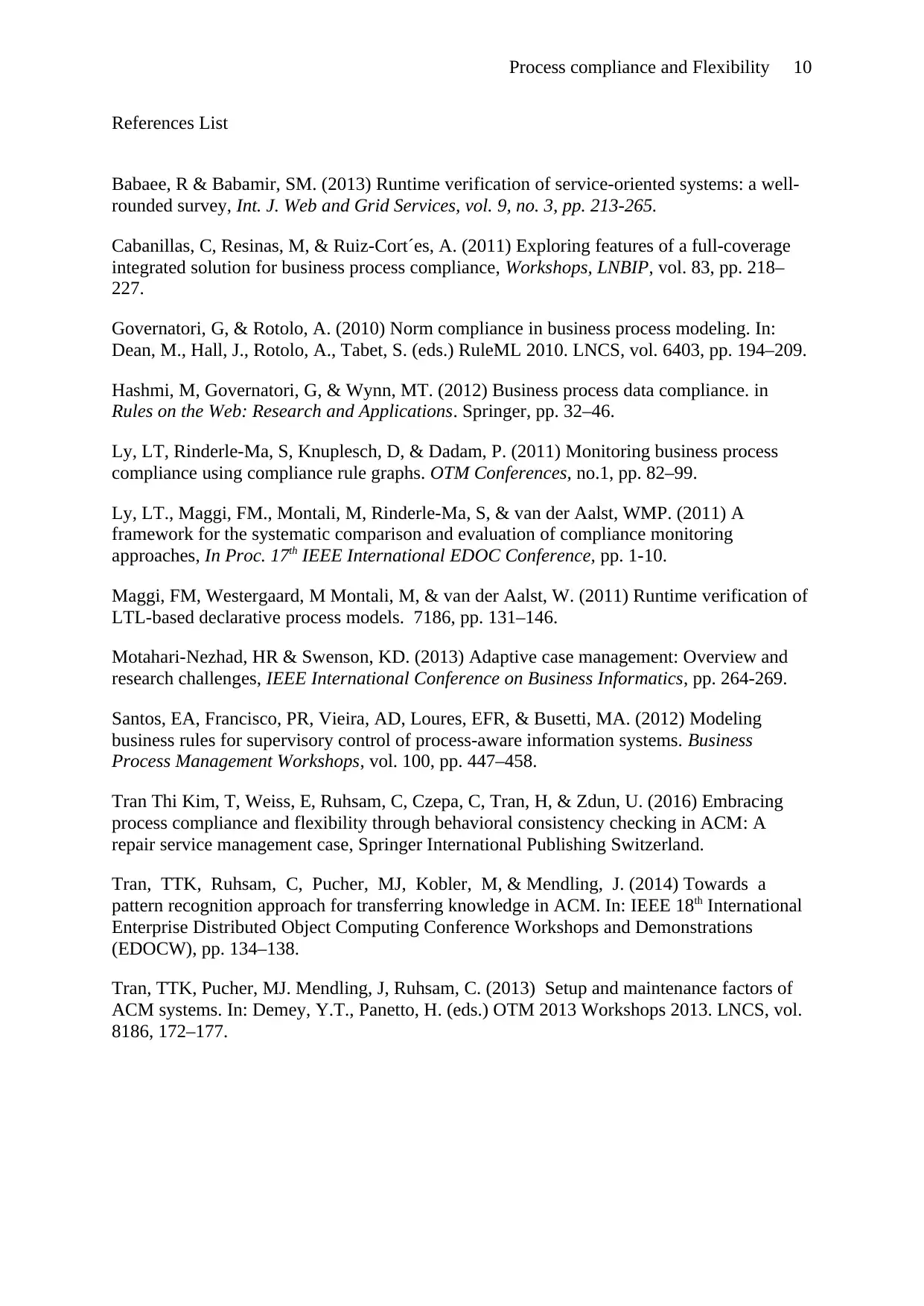
Process compliance and Flexibility 10
References List
Babaee, R & Babamir, SM. (2013) Runtime verification of service-oriented systems: a well-
rounded survey, Int. J. Web and Grid Services, vol. 9, no. 3, pp. 213-265.
Cabanillas, C, Resinas, M, & Ruiz-Cort´es, A. (2011) Exploring features of a full-coverage
integrated solution for business process compliance, Workshops, LNBIP, vol. 83, pp. 218–
227.
Governatori, G, & Rotolo, A. (2010) Norm compliance in business process modeling. In:
Dean, M., Hall, J., Rotolo, A., Tabet, S. (eds.) RuleML 2010. LNCS, vol. 6403, pp. 194–209.
Hashmi, M, Governatori, G, & Wynn, MT. (2012) Business process data compliance. in
Rules on the Web: Research and Applications. Springer, pp. 32–46.
Ly, LT, Rinderle-Ma, S, Knuplesch, D, & Dadam, P. (2011) Monitoring business process
compliance using compliance rule graphs. OTM Conferences, no.1, pp. 82–99.
Ly, LT., Maggi, FM., Montali, M, Rinderle-Ma, S, & van der Aalst, WMP. (2011) A
framework for the systematic comparison and evaluation of compliance monitoring
approaches, In Proc. 17th IEEE International EDOC Conference, pp. 1-10.
Maggi, FM, Westergaard, M Montali, M, & van der Aalst, W. (2011) Runtime verification of
LTL-based declarative process models. 7186, pp. 131–146.
Motahari-Nezhad, HR & Swenson, KD. (2013) Adaptive case management: Overview and
research challenges, IEEE International Conference on Business Informatics, pp. 264-269.
Santos, EA, Francisco, PR, Vieira, AD, Loures, EFR, & Busetti, MA. (2012) Modeling
business rules for supervisory control of process-aware information systems. Business
Process Management Workshops, vol. 100, pp. 447–458.
Tran Thi Kim, T, Weiss, E, Ruhsam, C, Czepa, C, Tran, H, & Zdun, U. (2016) Embracing
process compliance and flexibility through behavioral consistency checking in ACM: A
repair service management case, Springer International Publishing Switzerland.
Tran, TTK, Ruhsam, C, Pucher, MJ, Kobler, M, & Mendling, J. (2014) Towards a
pattern recognition approach for transferring knowledge in ACM. In: IEEE 18th International
Enterprise Distributed Object Computing Conference Workshops and Demonstrations
(EDOCW), pp. 134–138.
Tran, TTK, Pucher, MJ. Mendling, J, Ruhsam, C. (2013) Setup and maintenance factors of
ACM systems. In: Demey, Y.T., Panetto, H. (eds.) OTM 2013 Workshops 2013. LNCS, vol.
8186, 172–177.
References List
Babaee, R & Babamir, SM. (2013) Runtime verification of service-oriented systems: a well-
rounded survey, Int. J. Web and Grid Services, vol. 9, no. 3, pp. 213-265.
Cabanillas, C, Resinas, M, & Ruiz-Cort´es, A. (2011) Exploring features of a full-coverage
integrated solution for business process compliance, Workshops, LNBIP, vol. 83, pp. 218–
227.
Governatori, G, & Rotolo, A. (2010) Norm compliance in business process modeling. In:
Dean, M., Hall, J., Rotolo, A., Tabet, S. (eds.) RuleML 2010. LNCS, vol. 6403, pp. 194–209.
Hashmi, M, Governatori, G, & Wynn, MT. (2012) Business process data compliance. in
Rules on the Web: Research and Applications. Springer, pp. 32–46.
Ly, LT, Rinderle-Ma, S, Knuplesch, D, & Dadam, P. (2011) Monitoring business process
compliance using compliance rule graphs. OTM Conferences, no.1, pp. 82–99.
Ly, LT., Maggi, FM., Montali, M, Rinderle-Ma, S, & van der Aalst, WMP. (2011) A
framework for the systematic comparison and evaluation of compliance monitoring
approaches, In Proc. 17th IEEE International EDOC Conference, pp. 1-10.
Maggi, FM, Westergaard, M Montali, M, & van der Aalst, W. (2011) Runtime verification of
LTL-based declarative process models. 7186, pp. 131–146.
Motahari-Nezhad, HR & Swenson, KD. (2013) Adaptive case management: Overview and
research challenges, IEEE International Conference on Business Informatics, pp. 264-269.
Santos, EA, Francisco, PR, Vieira, AD, Loures, EFR, & Busetti, MA. (2012) Modeling
business rules for supervisory control of process-aware information systems. Business
Process Management Workshops, vol. 100, pp. 447–458.
Tran Thi Kim, T, Weiss, E, Ruhsam, C, Czepa, C, Tran, H, & Zdun, U. (2016) Embracing
process compliance and flexibility through behavioral consistency checking in ACM: A
repair service management case, Springer International Publishing Switzerland.
Tran, TTK, Ruhsam, C, Pucher, MJ, Kobler, M, & Mendling, J. (2014) Towards a
pattern recognition approach for transferring knowledge in ACM. In: IEEE 18th International
Enterprise Distributed Object Computing Conference Workshops and Demonstrations
(EDOCW), pp. 134–138.
Tran, TTK, Pucher, MJ. Mendling, J, Ruhsam, C. (2013) Setup and maintenance factors of
ACM systems. In: Demey, Y.T., Panetto, H. (eds.) OTM 2013 Workshops 2013. LNCS, vol.
8186, 172–177.
1 out of 10
Your All-in-One AI-Powered Toolkit for Academic Success.
+13062052269
info@desklib.com
Available 24*7 on WhatsApp / Email
![[object Object]](/_next/static/media/star-bottom.7253800d.svg)
Unlock your academic potential
Copyright © 2020–2025 A2Z Services. All Rights Reserved. Developed and managed by ZUCOL.


